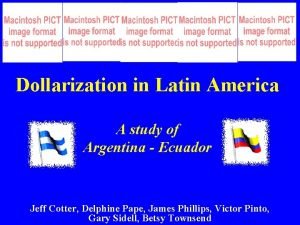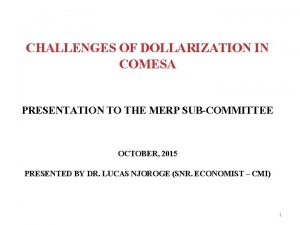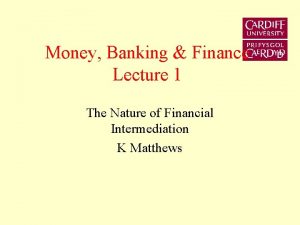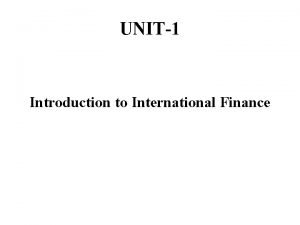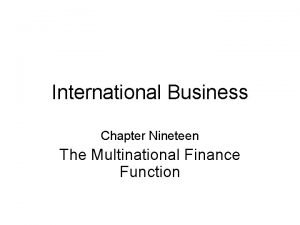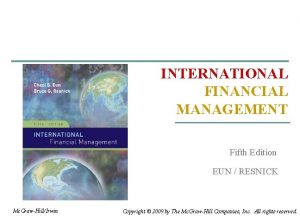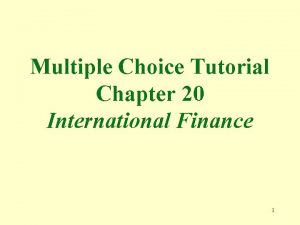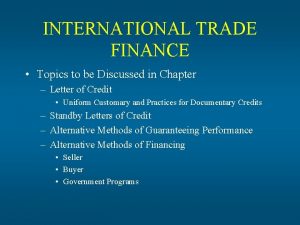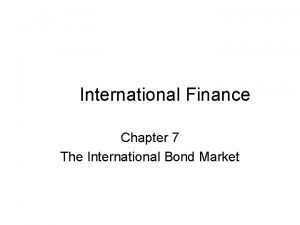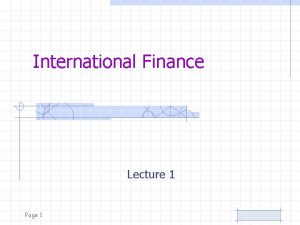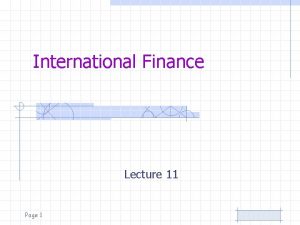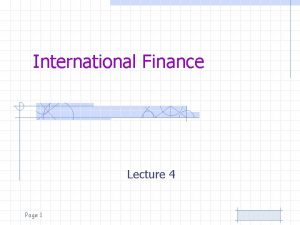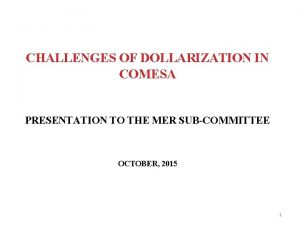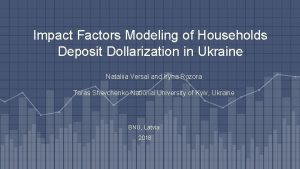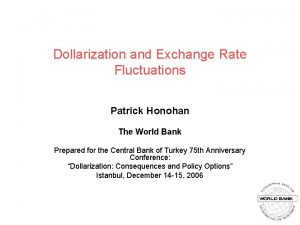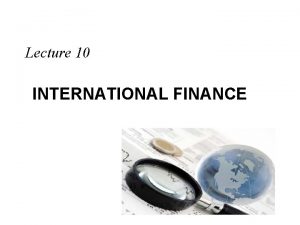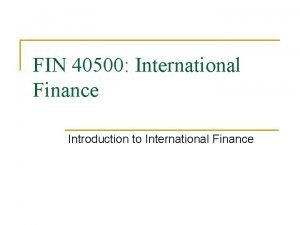Lecture 16 INTERNATIONAL FINANCE Review Dollarization e g















- Slides: 15

Lecture 16 INTERNATIONAL FINANCE

Review • Dollarization (e. g. Ecuador) • Single European currency – Impact on Monetary & Fiscal Policy – International trade – International flows – Impact on Exchange Rate Risk – Government Intervention – Adopted from South Western/ Thomson Learning 2006

Lecture 16 GOVERNMENT INFLUENCE ON EXCHANGE RATES

Government Intervention • Direct intervention refers to the exchange of currencies that the central bank holds as reserves for other currencies in the foreign exchange market. • Direct intervention is usually most effective when there is a coordinated effort among central banks. • When the central banks have high levels of reserves that they can use.

Direct Intervention • To force the dollar to depreciate, the Fed can intervene directly by exchanging dollars that it holds as reserves for other foreign currencies in the foreign exchange market. • By “flooding the market with dollars” in this manner, the Fed puts downward pressure on the dollar. • If the Fed desires to strengthen the dollar, it can exchange foreign currencies for dollars in the foreign exchange market, thereby putting upward pressure on the dollar.

Effects of Direct Central Bank Intervention in the Foreign Exchange Market Fed exchanges $ for £ to strengthen the £ Value of £ V 2 V 1 S 1 D 2 D 1 Quantity of £ Fed exchanges £ for $ to weaken the £ Value of £ V 1 V 2 S 1 S 2 D 1 Quantity of £

Reliance on Reserves • The potential effectiveness of a central bank’s direct intervention is the amount of reserves it can use. For example, the central bank of China has a substantial amount of reserves that it can use to intervene in the foreign exchange market.

Reliance in Reserves • As foreign exchange activity has grown, central bank intervention has become less effective. • The volume of foreign exchange transactions on a single day now exceeds the combined values of reserves at all central banks. • Consequently, the number declined. of direct interventions has • In 1989, for example, the Fed intervened on 97 different days. Since then, the Fed has not intervened on more than 20 days in any year.

Government Intervention • When a central bank intervenes in the foreign exchange market without adjusting for the change in money supply, it is said to engage in nonsterilized intervention. • In a sterilized intervention, the central bank simultaneously engages in offsetting transactions in the Treasury securities markets to maintain the money supply.

Government Intervention • Some speculators attempt to determine when the central bank is intervening directly, and the extent of the intervention, in order to capitalize on the anticipated results of the intervention effort. • Central banks can also engage in indirect intervention by influencing the factors* that determine the value of a currency. * Inflation, interest rates, income level, government controls, expectations

Government Intervention • For example, the Fed may attempt to increase interest rates (and hence boost the dollar’s value) by reducing the U. S. money supply. • Some governments have also used foreign exchange controls (such as restrictions on currency exchange) as a form of indirect intervention.

Exchange Rate Target Zones • Target zones have been suggested for reducing exchange rate volatility. Þ An initial exchange rate will be established with specific boundaries. Ideally, the rates will be able to adjust to economic factors without causing fear in financial markets and wide swings in international trade. I The actual result may be a system no different from that which exists today.

Intervention as a Policy Tool • Like tax laws and the money supply, the exchange rate is a tool that a government can use to achieve its desired economic objectives. • A weak home currency can stimulate foreign demand for products, and hence reduce unemployment at home. However, it can also lead to higher inflation.

Intervention as a Policy Tool • A strong currency may cure high inflation, since it intensifies foreign competition and forces domestic producers to refrain from increasing prices. However, it may also lead to higher unemployment.

Review • Government Intervention • Reliance on Reserves • Direct Intervention – Sterilized – Non Sterilized • Indirect intervention – Inflation, interest rates, income level, government controls, expectations – Adopted from South Western/ Thomson Learning 2006
 Dollarization in latin america
Dollarization in latin america De-dollarize
De-dollarize 01:640:244 lecture notes - lecture 15: plat, idah, farad
01:640:244 lecture notes - lecture 15: plat, idah, farad Indirect finance
Indirect finance International finance syllabus
International finance syllabus Ibfe
Ibfe Ifslearning
Ifslearning Increased competition
Increased competition Netting finance
Netting finance International finance logo
International finance logo Goals of international financial management
Goals of international financial management The current system of international finance is a *
The current system of international finance is a * Multinational financial system
Multinational financial system International accounting and finance
International accounting and finance International trade and finance topics
International trade and finance topics Types of bonds in international finance
Types of bonds in international finance
